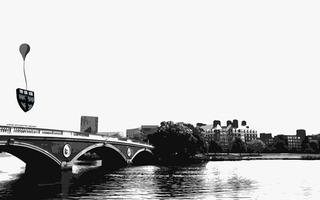Harvard scientists at the School of Engineering and Applied Sciences have succeeded in capturing light within diamond pillars embedded in silver, allowing them to release individual photons at a specific rate.
The research—published in the journal Nature Photonics earlier this week—will pave the way for future advances in quantum networks, in which information will be encoded and transmitted using quantum states of fundamental particles.
“Instead of using laser light to send information down optical fiber, here you would actually communicate using single photons,” explained Principal Investigator Marko Loncar, an associate professor of electrical engineering at SEAS.
“If you excite them in a certain state, they can stay in that state for a very long period of time. You can use it as a memory,” he continued.
Loncar’s research leveraged inherent defects in diamonds, called color centers, which usually just appear as discolorations on the surface of the stone. Sometimes, these color centers are accompanied by a tiny hole in the diamond called a vacancy. These vacancies can be used to emit red photons one by one, a process with great promise for the development of large quantum networks.
Loncar noted that their experiment differed from that of other researchers, since the team used standard techniques that would allow for easy scalability in the future.
“People have demonstrated one node or two nodes, which is very different from a microprocessor that has billions and billions of transistors,” he said.
Loncar said there are some aspects of the research that he hopes to improve in the near future. One issue is that a large percentage of photons are totally reflected inside of the diamond and, therefore, are essentially unusable.
He is already planning future experiments, in which he will manipulate silver in specific patterns to increase the proportion of photons than can be detected.
“To increase collection efficiency, we must essentially make a bullseye pattern on our pillar,” Loncar said. “We will have a target made of silver, and in the middle there will be a piece of diamond. Basically it is a grating which allows you to scatter photons out so they can be easily collected.”
Loncar’s research may also up new doors for the fields of data management and cryptography. Currently, ATM machines, as well as online banking and payment systems, often use extremely large prime numbers to encode sensitive data. Quantum networks may be substantially more secure.
Read more in News
Study May Enable Huntington’s Treatment TrackingRecommended Articles
-
Keats & Quanta: The Cat Is DeadWriters should address scientific themes appropriately or not at all
-
Scientists Employ Quantum ComputerIn a groundbreaking feat of computation, a team of international scientists—including Harvard researchers—have calculated the precise energy of a hydrogen molecule using a quantum computer.
-
Physicists Develop Quantum MagnetHarvard physicists at the Greiner Lab recently devised a “quantum magnet” that could aid with the development of high-temperature superconductors and quantum computers and may thereby expand the possibilities for future material science engineering.
-
Dingman Receives Advising AwardDean of Freshman Thomas A. Dingman ’67 received the first Freshman Advising Award at the Teaching and Advising Awards Dinner co-hosted by the Undergraduate Council and the Advising Programs Office on Wednesday evening.
-
 SEAS, Crossing Over
SEAS, Crossing Over -
 Greenblatt and Vendler Weigh In: What if We Abolished English Tomorrow?
Greenblatt and Vendler Weigh In: What if We Abolished English Tomorrow?













